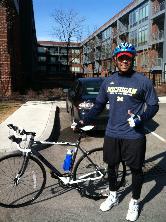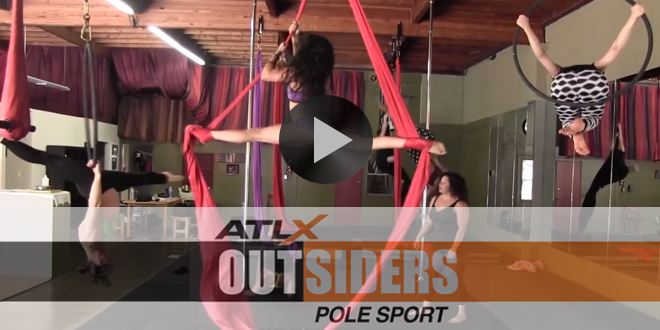By: Sarah McWilliams
Name: Jon’Tae Essex
Occupation: Home Lending Research Analyst, JP Morgan Chase
Jon’Tae Essex has battled plantar fasciitis, a torn Achilles, and plenty of bumps and bruises along the way. Although Essex has been an athlete all of his life, his recent discovery of cycling and adventure runs has upped his endurance and encouraged him to train longer and harder. Essex sat down with ATLX in this week’s everyday athlete profile.
Have you been athletic all your life, or did you experience an epiphany or transformational moment?
I’ve been an athlete my entire life, from Pee-Wee football all the way up until now. Sports and working out have been a driving force in helping me live a healthy and fulfilling life. I remember watching Barry Sanders play for the Lions as a kid and I wanted to be just like him. By idolizing him, it set me on a path for athletic achievement.
What do you do to train?
 I grew up playing basketball, football, baseball and running track, but lately I’ve gotten into running and cycling. It’s been great. I can’t begin to tell you how impressed I’ve been with how cycling has changed my workout habits and how positively my body has responded to it.
I grew up playing basketball, football, baseball and running track, but lately I’ve gotten into running and cycling. It’s been great. I can’t begin to tell you how impressed I’ve been with how cycling has changed my workout habits and how positively my body has responded to it.
How do you find the time to train with a full time job?
One word: prioritize. I make sure either the first thing I do in the morning or the first thing I do after work is get my workout in. If not you will naturally give yourself every excuse as to why you should skip this day or that. I realized if I can dedicate myself to excelling at work, I can do the same for my health.
Do you have bad days? How do you push through them?
Absolutely, sometimes staying late at work throws you off your schedule. Natural fatigue also develops from working long hours and can affect me, leaving me wanting to just relax at home. If I’m tired after work I will go ahead and rest, but then make sure I get up early enough to get a light workout in the next day. Those 30 minutes before work do so much for me mentally and physically, and sets my day off on a positive note.
One simple thing that also helps me is that I take the stairs. It can never hurt to pass on the elevator from time to time.
What types of races have you competed in?
The two most challenging races I’ve competed in are the Warrior Dash and the Tough Mudder, which was over 10 miles. They are both obstacle courses with around 10 and 22 obstacles respectively, with all sorts of challenges from jumping off a 20-foot platform into freezing water to running through electrically charged wires. You have to think on your feet and work with strangers to finish. The course is designed to test your will. Both were very exciting and different. When I finished I was ecstatic, because there’s no better feeling than an accomplished goal. It’s priceless.
What are your race plans and training goals for the future?
 I am currently training for the Pelotonia, a fundraising cycling ride in Columbus, Ohio that donates the proceeds to fund cancer research. I’ve signed up to ride 100 miles. As for training goals, I’ve been training to hit that six-minute-mile mark, ride 40 miles in 2.5 hours, and compete in additional obstacle course challenges, such as the Mud Ninja and Warrior Dash that are coming up for this summer. Finally, there’s a 5k Keg Tap Run that sounds exciting for this fall, because after all this grueling training you have to have some fun right?
I am currently training for the Pelotonia, a fundraising cycling ride in Columbus, Ohio that donates the proceeds to fund cancer research. I’ve signed up to ride 100 miles. As for training goals, I’ve been training to hit that six-minute-mile mark, ride 40 miles in 2.5 hours, and compete in additional obstacle course challenges, such as the Mud Ninja and Warrior Dash that are coming up for this summer. Finally, there’s a 5k Keg Tap Run that sounds exciting for this fall, because after all this grueling training you have to have some fun right?
What is your diet like? Are you strict about what you eat or do you burn enough calories to not have to worry about it?
A little bit of both, I’m training for challenges, not competitions, so I can still enjoy most of what I like. However, I can’t stress enough how eating a good breakfast helps control my appetite for the whole day. When I start my day off with something healthy, I subconsciously want to keep that going.
Do you lift weights or train outside of cardio?
 That’s one of the biggest things, coming from a person who has been through strength and conditioning programs. Functional and flexible muscle helps any athlete achieve their goals. I just decrease sets and increase reps to get the lean muscle that I desire. Lifting weights along with proper plyometric work can help anyone achieve what they’re looking for.
That’s one of the biggest things, coming from a person who has been through strength and conditioning programs. Functional and flexible muscle helps any athlete achieve their goals. I just decrease sets and increase reps to get the lean muscle that I desire. Lifting weights along with proper plyometric work can help anyone achieve what they’re looking for.
What is your motivation for living this lifestyle?
My motivation is that it’s so easy to say, “I can’t,” “I won’t,” and “I don’t feel like it.” At the end of the day, I don’t take that attitude in my career, and I can’t take that attitude in my personal lifestyle. For me, being active rubs off on every other facet of my life, from my overall attitude to how people perceive me. If I can achieve goals athletically, I can achieve them elsewhere. It just starts with that first step.
 ATLX The only sports entertainment television and digital media network fully devoted to everyday athletes, athletic lifestyle and athletic culture.
ATLX The only sports entertainment television and digital media network fully devoted to everyday athletes, athletic lifestyle and athletic culture.




